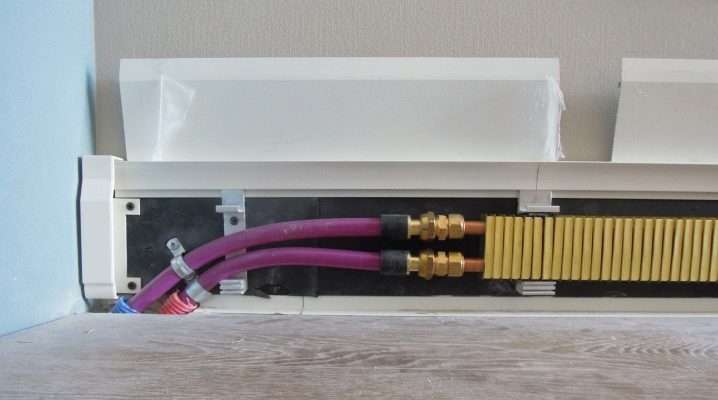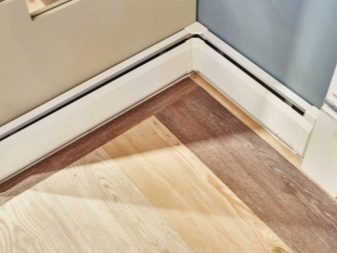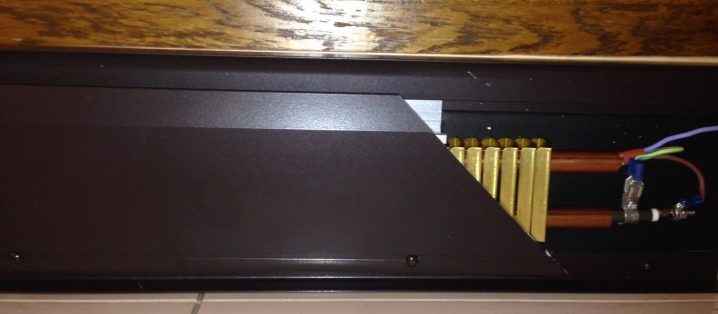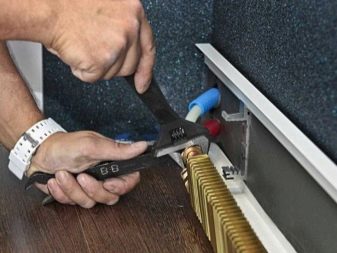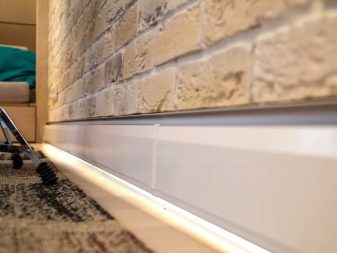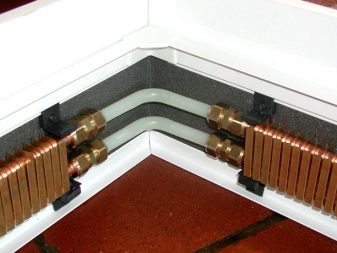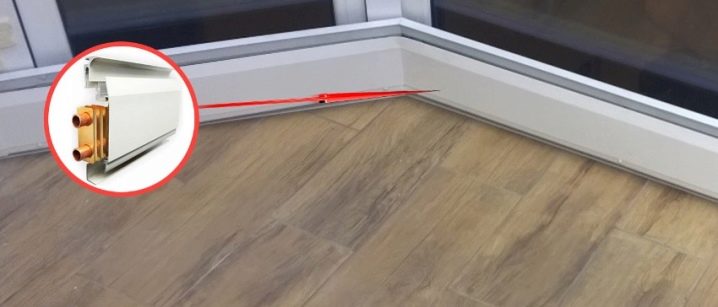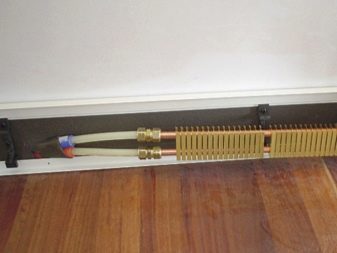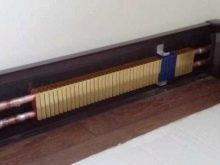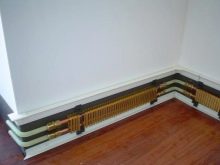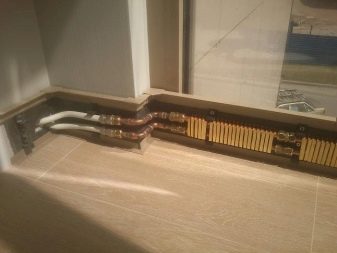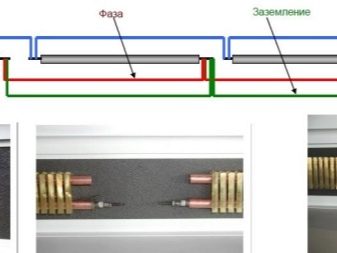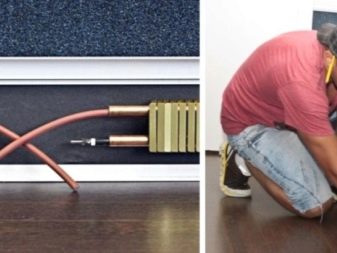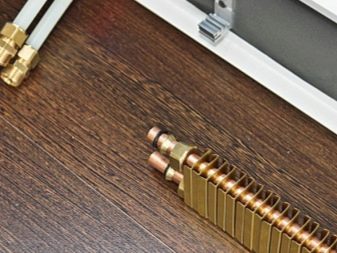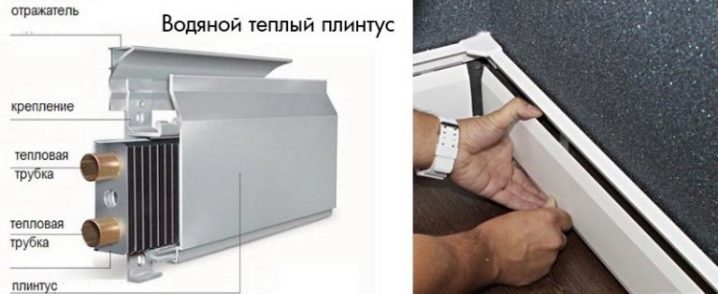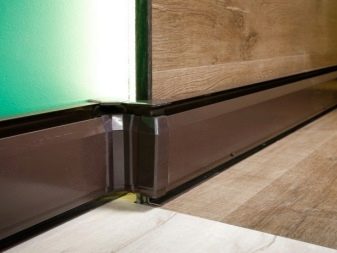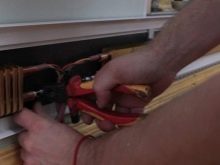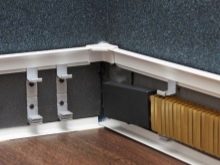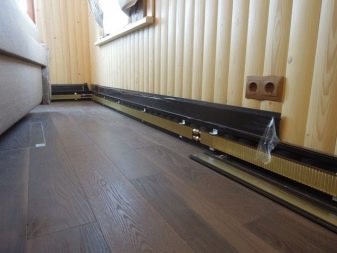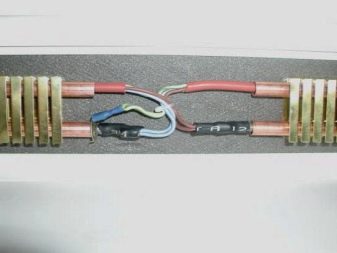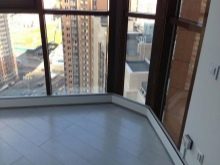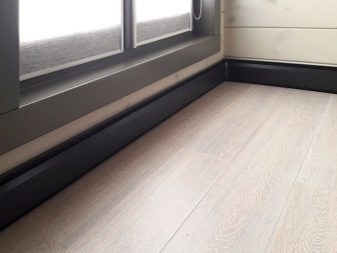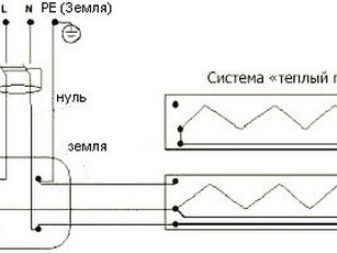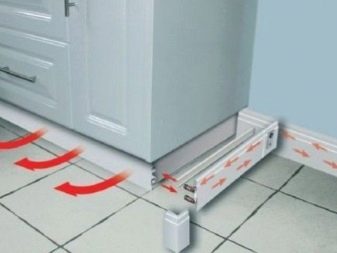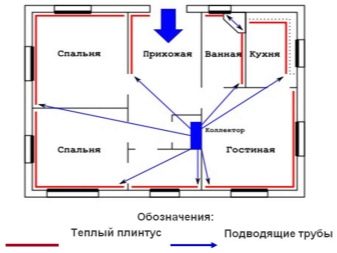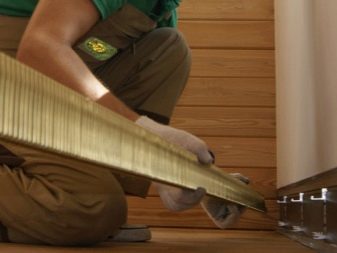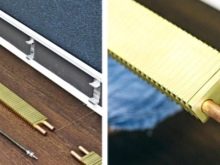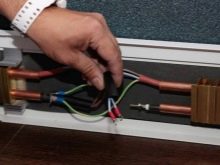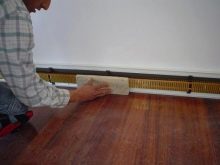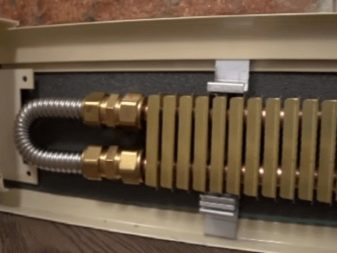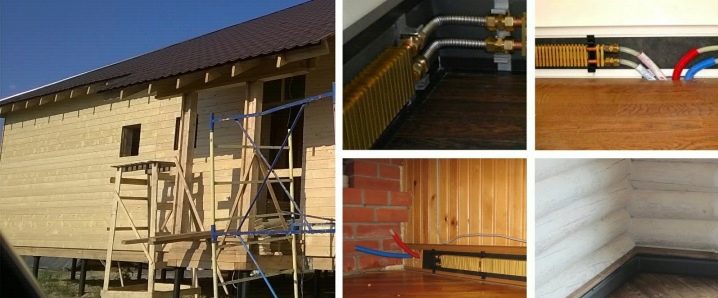Warm skirting: the subtleties of selection and installation
Proper heating is at the heart of the comfort and convenience of every modern building. If recently both private and apartment buildings were heated by special radiator systems - batteries and some types of convectors, now the market is gaining more and more popularity with the option of heating a house through laying warm skirting.
Special features
The first logical question that interests buyers and potential owners of baseboards is the design and principle of operation. The principle of operation of a warm plinth is extremely simple: in appearance, it resembles the most ordinary plinth, except that specially mounted heating elements are located inside an ordinary metal case.When exposed to thermal radiation, these elements gradually heat up and give up their heat to the metal baseboard for further distribution throughout the room. The advantages of this design quite a lot.
- Dimensions and footprint. Most of all, when choosing a technique, the area occupied by it is concerned, because each owner has repeatedly encountered the problem of lack of space or inconvenient location of the radiator. Such systems are very cumbersome, their installation is expensive, and if there is a need for repair, you will have to change the entire radiator battery, since in such systems there are almost no separate parts. The warm plinth is installed completely unnoticed, it does not interfere with the device engineering, and if any part of it is damaged, it can be easily noticed.
- The nature of the heating. Inexperienced buyers often face the problem of uneven heating of a room regardless of whether they use a split system, a convector, a boiler, or conventional central heating. There is always a risk that in some places the house will be warmer, in some - colder. Many are accustomed to these minor inconveniences and close their eyes.Warm skirting defies this stereotype attached to heating technology. The location of the plinth around the perimeter of the entire house ensures complete and uniform heating of the rooms.
- Effect on air masses - This is another important point, which frankly neglect the developers of many heating systems. Often the big problem with installing traditional systems is the cleanliness and lightness of the air. It can be difficult to breathe at high temperatures - it seems that the air is very heavy, dry, a small amount of oxygen is felt. Warm skirting does not have a negative impact on air masses.
- Safety use. Insulating metal elements make a warm baseboard suitable for installation near household appliances, furniture and even curtains.
- The cost of electricity. The peculiarity of the heating system is that if you put the average power on the radiator, it will be warm only near the device, and if you adjust the power to maximum, then we can hope that it will become warmer in the whole room. A large amount of energy is spent on heating remote areas, most of it is spent in vain and remains at the very point of heating.With warm skirtings, energy costs can be significantly reduced (sometimes by more than 30%), since their heating is uniform and all the heat is rationally consumed.
- Appearance. Minimal, but still important plus warm baseboards - a large variety of shapes, colors and sizes. The small size allows you to choose a baseboard for the interior of the room and give the design a sophisticated and minimalistic look.
If we consider the traditional methods of heating rooms, the main problem is the same uneven distribution of heat.
If it is simpler to say - traditional heating is set in such a way that heated air flows accumulate near the ceiling of the room., and the lower tier (floor) remains the same cold. If in rooms with low ceilings this does not interfere with comfort, then for penthouses this is a tangible problem. In order to cope with this, built-in fans can be found in a complete set of traditional types of heating - and here there are two points: the fans really mix the air masses, creating a more or less uniform, but active air circulation raises dust, which is already dangerous for people with lung diseases and bronchial tubes.
The unique design of warm baseboards works as follows:
- first, it is the heating of the lower layers of the air that takes place, because it is in the lower layers of the air that we relax, drink coffee, watch TV;
- Further, the air gradually rises along the walls, warms them up and, as a rule, does not reach the ceiling.
Why this principle of work is important and effective - even in the most modern apartments there is such a thing as dampness and the appearance of fungus on the walls. This happens with the installation of traditional models, since the heat rises to the ceiling along the walls, not heating them significantly. The walls remain cold and damp, and the heat and dampness in combination create condensation, with a large draft of which molds form on the walls.
Such a system has its drawbacks, because even the most autonomous and optimized equipment cannot do without them.
- High price categories. It turned out that the more common some type of equipment, the more competition - there is a struggle for buyers, which necessarily includes lower prices. As for the warm plinths, it is hardly possible to meet them in the homes of friends or acquaintances, someone prefers a split system, someone convector heating. The unpopularity of the product from the mass public makes it much more expensive, but at the same time unique.
- More complex installation and installation process. To mount a conventional radiator system, which can be more and more often noticed by pre-installed options in new buildings, there is almost no need to take any effort, the same applies to split-systems. Convectors can be simply bought, pushed in the right place or mounted to the wall of a room, and in the same evening you can enjoy some kind of heat. Warm plinths are more difficult to install, since they consist of a large number of elements, for the installation of which you need to have considerable experience.
- Disadvantages of installation and further use. If we are talking about installing a warm plinth in an apartment with walls that are covered with wallpaper, it should be remembered that with excessive heat, even the highest quality glue dries out, its structure is destroyed. As a result, the integrity of the wallpaper is damaged, so-called thermal wallpaper harmonicas are formed.
- One of the positive parameters of warm baseboards is safety of use. To achieve comfort in the room through the operation of these systems, average settings will be enough, which significantly reduces the possible fire risks.But at the same time, the case of warm baseboards is metallic, so you should still protect yourself and keep fusible elements away from baseboards. The safety of moving around the apartment can be attributed to the last point - although the corners of polymer and natural baseboards are usually softened with nozzles, a blow to any part of the body of these elements can cause unpleasant sensations. The metal case of warm plinths is not an exception to the rule, so you should be careful.
Kinds
Today, there are only two common types of warm baseboards - water and electric. Each of them is used in the specific conditions of the device rooms and furnishings of the apartment itself. It is worth considering each of the types in detail.
Water
This installation option is quite common - it can be seen in the interior of some modern residential buildings, office space, even shopping centers. It is worth noting that the water type of warm baseboard is widespread in many Western countries. Such interest is due to factors such as: ease of use and low maintenance requirements.Water warm baseboard is an externally metal panel or box, inside which there is a heating or heating module with mini tubes for water supply and heating. The outer or back side of the device is also equipped with a metal panel, which is already designed to protect the wall itself from high temperatures.
Unlike the electric type, which can be powered from an ordinary external network, the water type needs an additional connection to the collector systems.
This method of connection by technicians is called radial. The difference of this type of warm plinth from the electric is a wide range of possible installations in the interior. Warm water skirting can be mounted in the attic, loggia, even on the balcony, while the heating efficiency is not reduced, and energy costs remain relatively small. Another feature of the water type is the rapid warming of the air, since the physical properties of water make it possible to transfer even the hottest streams through the pipes without hindrance. However, it is necessary to constantly monitor the temperature level in boiler rooms.
Electric
If a watery variety of warm baseboards is appreciated for quick heat and ease of maintenance, electrical type is common due to the following characteristics:
- ease of installation works - unlike the water type, the electric is installed on site, the installation process is simple and fast, because it is enough to fix the heating panels on the wall;
- availability of more advanced heat control systems - most models of water plinths are not equipped with special devices for temperature measurement - it’s enough to follow the average water level in boiler rooms. The electric type is often equipped with specialized thermostats, which are similar to ordinary thermometers. Thermostats can operate either automatically or can be adjusted manually, and their work is aimed at optimizing energy costs.
Here it is worth noting the negative aspects of the use of such plinth:
- high energy consumption - when using any equipment with power supply, the question of monetary costs arises. Electric type, unfortunately, even in the presence of thermostats consumes a large amount of energy;
- The installation of the electrical type is much simpler, however, the connection process itself may cause some difficulties - this is the preparation of the dedicated line with the correct nominal value;
- One of the potential drawbacks for many customers is the availability of power. The likelihood of damage to the wiring and the occurrence of fire is extremely small, however, for some it is a determining factor under certain operating conditions.
If the buyer liked the water variety more, then do not despair and think that these species differ in appearance.
In addition to the presence of terminals or fasteners of wires to the electrical supply, these types are absolutely identical in appearance. It is worth noting such a type of plinth equipment, such as infrared warm plinth. The peculiarity of this type is the use of a special film tape, which, under the influence of high temperatures, heats up and becomes a peculiar source of infrared radiation, which provides additional and high-quality heating of the room.
How to choose?
When choosing a thermal plinth, be it water type or electric, should be guided by certain parameters of the room.
- First, it is worth assessing the power consumption possibilities - a certain monthly or daily limit of electricity consumption is set for many residential buildings (it’s pointless to cite the figures, as we are talking about different cities and different heating systems). It is necessary to calculate how many kilowatts you can donate to the work of a warm plinth - it should be remembered that all electrical appliances are included in the accounting of total costs. Based on the appraisal of the apartment, certain models of baseboards with suitable characteristics are already selected.
- Do not forget that the installation and installation of thermal baseboards is recommended more for newly built apartments, because the installation of these systems will be more convenient in the very first stages of room planning. If the water variant is meant, there may be no significant problems during installation, but some electrical options may require some sort of dismantling of the walls, for example, for wiring.
- Depending on the material from which the walls of a building or room are made, the thickness of warm baseboards may differ.The same reinforced concrete, from which most of the still-old residential buildings are made, has low thermal insulation, if we are talking about a private house with specially mounted thermal insulating elements, then you should think about buying a not so powerful warm plinth.
- The typical characteristics of the room in which the thermal plinth will be placed should be taken into account. Some manufacturers carry out individual orders for the production of baseboards of strict length, but to a greater extent they are represented by standardized models that may not fit the size of a balcony or loggia.
These recommendations are simple, however, you need to remember that when calculating the characteristics of the room and the limit on energy, it is better to turn to specialized workers.
It will cost money, however, acts as a guarantee of correct calculations.
Payment
For some technicians, the possibility of self-calculation during the construction or installation of a device is one of the main factors of its choice among other systems. This desire can be understood, because no one wants to spend extra money to attract specialists. And I must say that in vain.To accurately calculate all the characteristics of the room and the work of heating systems in a particular room, you can spend more than one hour. As already written, this is the calculation of the typical values of the room, and the thermal conductivity of the material of the walls, and the electrical limit. Not to mention the simple calculations of the perimeter of the room and the height of the ceilings. To make the data more accurate, even the heat conductivity of windows and doors should be taken into account. Therefore, technicians often use the averaged figure or the average variant of the location of warm baseboards in the apartment.
Frequent difficulties are encountered in calculating the heating for individual buildings, which are presented with a large number of extensions. - balconies, attic, attics, layers of insulation and waterproofing. Based on the data received, high-quality heating of 1 m² requires an average of 100 W of thermal energy. This figure is derived from the average characteristics of the heating room. From this we can conclude that to calculate the average power of the required plinth, multiply the number of squares of the room by 100. The resulting figure is a kind of minimum (for more efficient work it is advised to increase it by another 15-20 percent).These simple calculations will help determine the average total heat energy of all the elements of a warm baseboard.
To determine the exact length of the communications plinth thermal, you need to determine the amount of heat emitted by one meter of the heating system.
If it is about 60ºС, then we get about 178 watts. Further, it is necessary to divide the number obtained from multiplication by 178 and get the amount of necessary plinth in meters. Again, this figure should be slightly increased (up to 30 percent), which will make it possible to more effectively regulate the temperature at different times of the year. It should be borne in mind that this is only averaged data. No one will give a full guarantee that they will fit a certain room.
Installation
Each type of warm skirting can be installed by hand.
To do this, just follow the following step by step instructions for action:
- To begin, you will need a detailed plan for the installation of insulation systems. The construction itself is located at a distance of 10 mm from the floor and 15 mm from the wall itself, which is done intentionally to prevent overheating and system overload;
- you need to make a markup of the level of the layout of the plinth (usually using a paint cord or other available tools). Care should be taken to ensure that the line is level.It is worth remembering that this placement is determined by taking into account the gaps. Next, you need to take the back panel of the plinth and mark the hole for drilling;
- The further process is quite simple - dowels of 6 mm are placed in the holes, after which the back panel of the plinth is fixed with screws. After this, the heating modules are connected in series (no more than 17 with a power of more than 200 W);
- after the installation of the modules, the entire structure is covered with a metal casing, and plugs are installed. Be sure to ground the cables of the design and install the supply jumpers;
- To keep abreast of the condition of a particular segment of the warm plinth, thermostats are installed. When installing them, it should be understood that the device should be located in an open place, at a height of up to 1.5 m above the floor. Heat regulators are not the most accurate temperature measurement technique, so they can react to the outside temperature in the room;
- after the installation of the device, it is necessary to prepare a special place for laying wiring and connecting cables with baseboards;
- The most important step in the installation of any type of warm baseboards is to check the quality of the installation. To this end, the design is tested to check the degree and efficiency of heating, the operation of the thermostat and assess the correct installation of the entire system.
Tips and tricks
So, it is worth noting that heating apartments and houses with the help of a warm plinth is one of the most promising areas of space heating today. It has a great technical potential, its versions are stronger, more reliable and more comfortable than traditional ones. Warm skirtings have been known since the beginning of the 20th century and have already managed to form their own base of positive ratings and reviews. There are only two general recommendations for future builders and already experienced developers.
- No need to look for the perfect formula for installing baseboard heating in the room, because it does not exist. However, one should not be afraid to work with plans, figures and tables, as accurate calculations of the parameters of the room, technical data, individual characteristics of the building and the structure will help to make a complete picture of the conditions of future operation.
- Technical progress has made such a level that even the most familiar household appliances can be excellent additions to the interior. The design of warm plinths is unique, it is so versatile in color and design combinations that you can create an individual warm baseboard - reliable, durable and beautiful.
The process of installing a warm plinth, see the video below.
